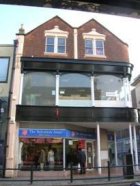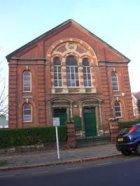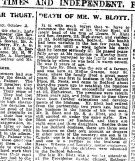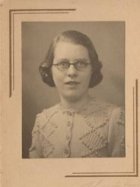Bedford
High Street History
Places > Bedford > Streets > High Street
Blotts - Drapers
113 High Street
Home | Blotts | Blott Family |Sources | Images
Blotts
 The
drapers shop at 113 High Street was run initially by Walter Blott, who was born
at Midloe Grange near St Neots, the son of a farmer. He started business in St Neots Market Place. He moved to Bedford in approximately 1888 and it would
appear that he took over the drapery business at 113 High Street from Ezra
Braggins, who moved to the site now occupied by Beales on the corner of Silver
Street and Harpur Street.
The
drapers shop at 113 High Street was run initially by Walter Blott, who was born
at Midloe Grange near St Neots, the son of a farmer. He started business in St Neots Market Place. He moved to Bedford in approximately 1888 and it would
appear that he took over the drapery business at 113 High Street from Ezra
Braggins, who moved to the site now occupied by Beales on the corner of Silver
Street and Harpur Street.
Walter Blott was living at 11 Goldington Road with his wife, Mary Emma, and their large family by the time the 1891 census was taken. His eight sons were called Reginald, Walter, Ivo, Leonard, Shirley, Jonathon, Arthur and Roy. He had at least three daughters and perhaps a fourth, as I have found a possible discrepancy between the names on the census and in the obituary mentioned below. They appear to have been called Olive, Hilda, Mary and Ivy Madge. Walter died in 1922 at the age of seventy-one, two years into retirement. His oldest son, Reginald, took on the management of the shop, assisted by his brother, Shirley. According to his obituary, Walter Blott, was a regular attendant at Providence Baptist Chapel, Rothsay Road, which dates back to 1894, and he took a great interest in that place of worship, of which he was a trustee and sides man. The High Street shop appears to have been rebuilt in the early years of the twentieth century and there were further developments and extensions of the business over the years. I obtained my information from the 1891 census, building plans which are kept at the Bedfordshire and Luton Archives and Records Service (BARS), and Walter Blotts obituary in the issue of the Bedfordshire Times and Independent dated 27th October, 1922. Blotts drapery is of particular interest to me as I knew two of Reginald's many daughters very well.
I put out a brief questionnaire about Bedford High Street and Blotts to people who were living in or near Bedford over 40 years ago. I was delighted to discover that the mother of a friend of mine from Christ Church Bedford, Olive Kirby had worked at Blotts. Olive was born on 2nd August 1917 at 1, Howard Street, Bedford, the only child of Sidney and Dorothy Rawlins. Her father was an engineer at Allens.
Olive started her working life by serving a three year apprenticeship at a little baby linen shop in Harpur Street, which was later taken over by Halfords. She then worked briefly at the Manchester and Bradford just across the road, before moving on to Blotts, in 1935 because Mr Blott needed someone. She did not have an interview for the job. She thinks Mr Blott came to her home and asked her to go and work for him. He would have known her, because both families attended Providence Baptist Chapel in Rothsay Road. Olive has no particular recollection of her first day at Blotts, referring to it simply as quite an ordinary day. She describes Mr Reginald Blott as a tall man, who was a nice person to work for. His daughters, not necessarily in age order, were Dorothea, Audrey, Lois, Emma, Ruth, Ranah, Joyce, Olive and Joan. Reginald had just two sons, Paul and Timothy.
The people Olive worked with at Blotts included Marjorie Flood. Olive was also able to name Dorothy Day, Miss Perkins, Miss Hall, Joan Housden, Miss Black and Miss Fletcher. Olive described for me the upstairs of the shop, which was a show room that sold coats and other items of ladies clothing. Downstairs was what they called the Manchester Department, with sheets, blankets and other bed linen, plus various household goods, including tea-towels. There was also fabric for dress-making, haberdashery items and knitting wool for sale. Olive worked at various times in the haberdashery and the gloves and hosiery departments and finally in the Manchester Department. She recalls that items were hung and displayed in the street down the side of the shop to attract customers. There was also a glass cabinet in front of the shop. According to Olive, once a week, on a Saturday afternoon, the contents had to be removed and taken inside. The blinds were pulled down then in readiness for the Sabbath so that nothing was on show. None of the employees lived on the premises at that time.
Blotts was located on the east side of Bedford High Street, on the northern side of the junction with Lurke Street. The premises are now occupied by the Salvation Army Charity Shop. Olive told me that she has been in there, but that the large building has been changed to such a degree over the years that she hardly recognised it. Olive used to travel to and from Blotts from her home in Palmerston Street on her bicycle. For reasons unknown to her, the top floor of the three storey building was referred to as the cellar! She and Marjorie Flood used to do fire watching up there during the War. Olive remembers fire watching at Blotts the night that incendiary bombs were dropped on Bedford. When asked how much she was paid, Olives reply was: Not very much. I think, when I left, I was getting about twenty-eight shillings a week. That is 1.40 in today's money!
Olive married Archie Kirby from Renhold on 4 April, 1940, some seven months into the War. Olive left her employment at Blotts then, as married women were not allowed to continue working in those days. However, she returned to Blotts, after Archie was called up in the June to serve in the Army. He was imprisoned in Thailand and did not return home until November, 1945, at which time, Olive left Blotts for the last time. She thinks the shop closed fairly soon after that, either at the end of 1945 or during 1946. It had certainly gone and been replaced by Richard Shops by the time the 1947 Kellys Directory, the first one I could find after the War, was published. Looking back on her time at Blotts, Olive remembers finding the people she worked with very pleasant and also getting on well with everybody. It was not as easy going as it is these days. It was quite different in the management and how they worked. I was delighted to find someone who had worked in Blotts shop and had such vivid memories of what it was like.
More information about Blotts came from Eva Bunn (ne Woolston) who was born on 11th August, 1917, just a few days after Olive Kirby. Eva lived in Park Road with her two brothers and four sisters and attended the Girls Modern School, which became the Dame Alice Harpur School, and remembers the three youngest Blott girls being there, that is Olive, Joyce and Ranah. Eva did not often shop in Blotts. The implication seems to be that it was a little on the exclusive and expensive side. I received a similar comment from Dora Chamberlain (ne Caress), who was born in 1914, and from Rona Rowlands (ne Alcock), who was born in 1930. Peggy Palmer told me that Mr (Reginald) Blott used to offer to give a copy of John Bunyans Pilgrims Progress to anyone who did not have one.
On the BBCs WW2 Peoples War website, I found an item about Dorothy Turner (ne Day), one of the people Olive Kirby remembers working with, which states: I started working at Blotts the drapers in the High Street, aged 14 years old in 1937. At the beginning of the war I was asked to do the Fire Watch at night time which involved myself and my friend sleeping overnight (on a staff rota) at the top of the shop, the second floor of the old building. If there had been any trouble we would have had to contact Mr Fuller, who owned and lived in the garage in Lurke Street, at the rear end of the shop. Fortunately, we didnt get into any difficulties as we hadnt had any training.
Gwen Gribble (born in 1931) remembers that, when she was a child, her mother, Miriam, and her aunt used to meet at Blotts at three oclock on a Tuesday afternoon. They used to buy knitting wool and the price was given as one three (which was a penny three farthings) or two three (which was tuppence three farthings). Cynthia White moved to Bedford in 1959, long after Blotts shop closed, but she does remember the three tall Miss Blotts (Joan, Emma and Ranah), who lived opposite her family on Goldington Road and rode stately upright bicycles.
Elizabeth Mortimer 2011
Postscripts
It was because of my interesting interview with Olive Kirby that I was put in
touch with Toby Friedner of BBC Three Counties Radio who was conducting a series
of interviews about High Streets in the region. On 1st December 2012 we stood
outside the Salvation Army Charity shop in the bitter cold trying to hear each
other above the noise of the traffic and the nearby pedestrian crossing.
The interview was broadcast on BBC Three Counties Radio at 6.50am, Monday 6th December 2010.
Having been unable to contact Mr Timothy Blott when I carried out my original research into the history of Blotts Drapery on Bedford High Street, I was delighted to have the opportunity to meet him and his younger son, James, a couple of years later in 2012 and discover further information about Blott's Drapery and the Blott Family.
Sources
Bedford Local Studies and Heritage Library (HL) and BARS
- 1891 Census
-
Bedford Directories (HL)
-
1896 plans for alterations to Blotts Drapery, 113 High Street, Bedford (BARS)
-
Advertisements and photographs (BARS)
-
Bedfordshire Times and Independent 27th October, 1922. Death of Mr W. Blott
-
The Eagle vol. 30, Summer 1956, p.467 Obituary, Mr R. Blott
-
Bedfordshire Times and Standard 30th March, 1956, p.11. Death of Mr R. Blott, Bedford trader for many years
-
Interview with Olive Kirby November, 2010
-
BBC WW2 People's War Dorothy Turner's Memory of working at Blotts
-
Replies to questionnaire sent out about the High Street and Blotts
Images
Page last updated: 28th January 2014



